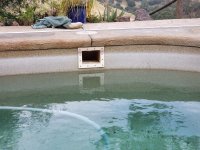- Aug 27, 2012
- 29
Greetings,
I have a fiberglass pool with a Sta-Rite skimmer. We have a leak in the pool and are fairly sure it is at the front edge of the skimmer. We were going to seal the gap, but realized (if we understand the construction correctly) that there is a gasket between the skimmer faceplate, and the fiberglass pool. It looks like this gasket is a black rubber foam material, and it seems like ours is badly degraded, and might be responsible for the leak. So we'd like to replace the gasket, and at the same, we'd like to replace the faceplate since it is discolored.
I think I have found the right Pentair replacement parts. The faceplate looks like it is U-3 Skimmer Face Plate WC2-8P. Someone told me the gasket is Pentair part #U9-366, and I have seen evidence that this is indeed the case. And yet the skimmer face is only 10.75" wide, while the gasket is 11" wide; I don't remember the previous gasket being wider that the face plate, but I could be wrong.
Anyway, is this an easy thing for a handy homeowner to do? Is it as simple as screwing off the current plate, peeling off the decaying gasket, and then replacing with new gasket and face plate? I am always a little nervous with respect to pool stuff, and i don't want to open something up only to find that there is something unexpectedly tricky about the replacement process. I mean...it seems straightforward, but it never hurts to have reassurance!
Thanks
Otherchuck
I have a fiberglass pool with a Sta-Rite skimmer. We have a leak in the pool and are fairly sure it is at the front edge of the skimmer. We were going to seal the gap, but realized (if we understand the construction correctly) that there is a gasket between the skimmer faceplate, and the fiberglass pool. It looks like this gasket is a black rubber foam material, and it seems like ours is badly degraded, and might be responsible for the leak. So we'd like to replace the gasket, and at the same, we'd like to replace the faceplate since it is discolored.
I think I have found the right Pentair replacement parts. The faceplate looks like it is U-3 Skimmer Face Plate WC2-8P. Someone told me the gasket is Pentair part #U9-366, and I have seen evidence that this is indeed the case. And yet the skimmer face is only 10.75" wide, while the gasket is 11" wide; I don't remember the previous gasket being wider that the face plate, but I could be wrong.
Anyway, is this an easy thing for a handy homeowner to do? Is it as simple as screwing off the current plate, peeling off the decaying gasket, and then replacing with new gasket and face plate? I am always a little nervous with respect to pool stuff, and i don't want to open something up only to find that there is something unexpectedly tricky about the replacement process. I mean...it seems straightforward, but it never hurts to have reassurance!
Thanks
Otherchuck


